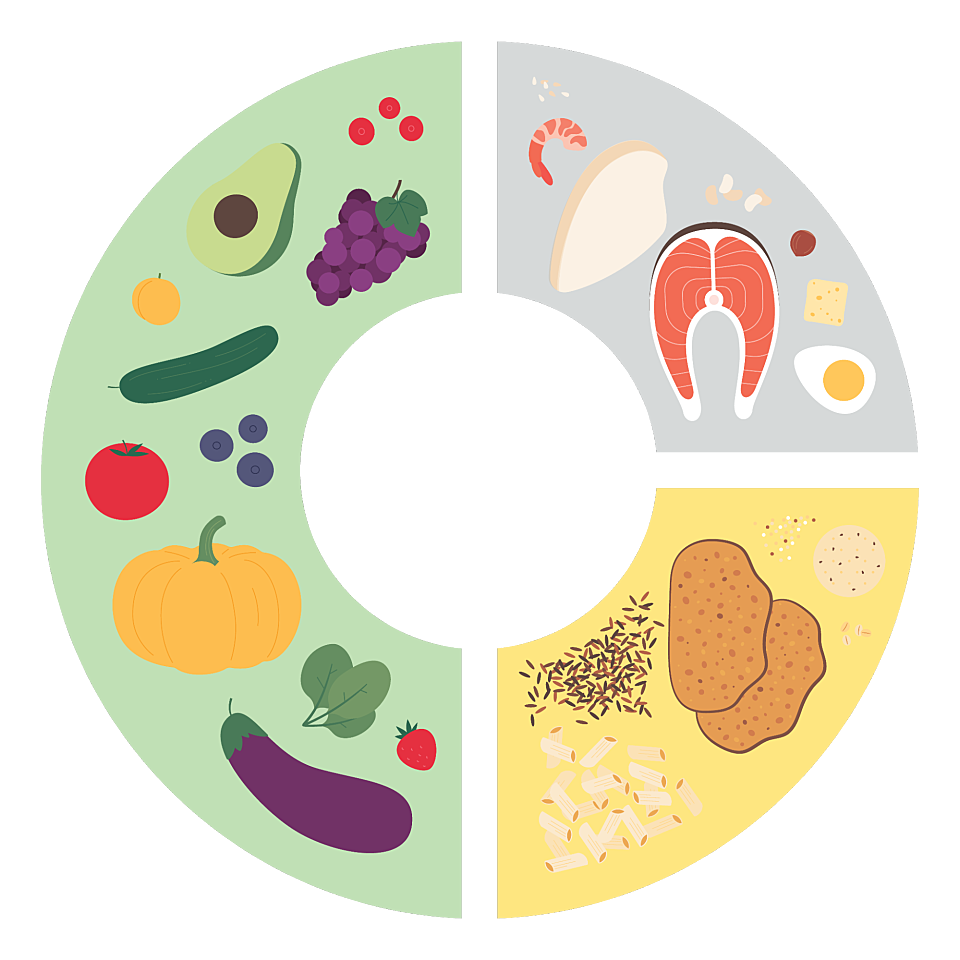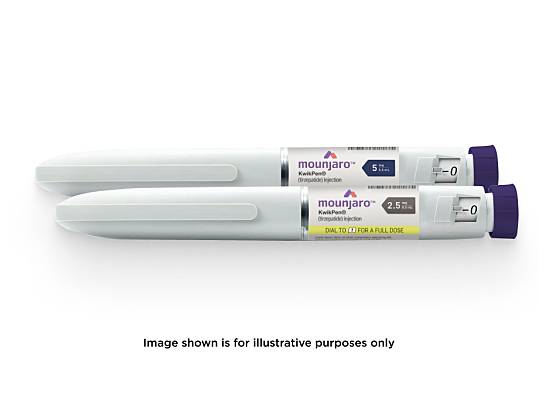What to Eat on Mounjaro

Medically reviewed by
Dr Brenda IkejiLast reviewed: 09 Oct 2024
Mounjaro, the weekly weight loss injection, is a popular treatment that can help people lose up to 22.5% of their starting weight on the maximum maintenance dose (15mg of tirzepatide) after 72 weeks.
The effects of Mounjaro include a reduction in appetite and increased feelings of satiety (fullness), but it must be taken alongside a diet and exercise regime to work effectively.
Knowing what to eat, limit and avoid on Mounjaro, will help you get the most out of your treatment and reduce side effects. This guide includes the best food groups to add to your Mounjaro diet plan, meal ideas and some extra tips for effective weight loss.
Why diet is an important part of Mounjaro treatment
Mounjaro studies show that 89% to 96% of people lose 5% or more of their starting weight while taking this weight loss treatment for 72 weeks. Participants in the trial took Mounjaro alongside a reduced-calorie, balanced diet and increased exercise.
What you eat on Mounjaro is important because:
- Mounjaro causes you to feel less hungry, but this won’t cause weight loss alone. Reducing your daily calorie intake by around 600 calories is the best way to lose weight, although this number is slightly different for men and women. It can be hard to reduce how much you eat, but Mounjaro makes it easier by stopping feelings of hunger and keeping you fuller between meals.
- Eating healthy, balanced meals will ensure you get the nutrition you need while losing weight safely. Not getting enough essential nutrients and vitamins from your diet can cause nutritional deficiencies, impacting your weight loss journey and causing other health problems.
- Mounjaro, like all medications, can cause side effects. Most of these are gastrointestinal (GI), meaning they affect your stomach and bowels. Common side effects include nausea, vomiting, diarrhoea, stomach pain and acid reflux. Eating foods that make these worse could make it harder to manage Mounjaro side effects. Similarly, eating the right foods may prevent or make GI side effects more manageable.
- Losing weight, building muscle mass and eating well can reduce your risk of weight-related medical conditions. Mounjaro can be prescribed to treat obesity and people who are overweight with a weight-related health problem. Taking Mounjaro alongside the right diet may prevent any weight-related health conditions (such as prediabetes, high cholesterol or high blood pressure) from worsening, and may even provide long-term relief from them. Your doctor may consider weight loss treatment to help improve your long-term health outcomes.
“Mounjaro is prescribed as part of a long-term obesity treatment plan, so you can lose and maintain a healthy weight. A Mounjaro diet plan shouldn’t be overly restrictive (completely cutting out major food groups like carbohydrates) or be seen as a ‘crash diet’. Instead, it can teach you how to create nutritionally balanced meals and live a healthier lifestyle while on Mounjaro and after you finish treatment.” – Dr Brenda Ikeji, Medical Editor.
from £179.00

No results found.
Please check your spelling or try another treatment name.
What to eat on Mounjaro
There is no set Mounjaro diet plan – instead, you should focus on making balanced meals that contain all the food groups and nutrients you’ll need. This means that even if you eat less while taking Mounjaro, you won’t become low in nutrients, vitamins or energy, and you’ll be eating foods that improve your health and wellbeing at the same time.
Protein
Protein is a macronutrient and is made of amino acids. Amino acids are needed by the body for essential functions, such as:
- creating antibodies to keep your immune system healthy
- building and repairing tissues, muscles, bones and cells
- increasing energy levels – protein is one of 3 main energy sources, the others being carbohydrates and fat
- making enzymes that help with digestion
- regulating hormones
Stick to low-fat and lean protein sources, as these contain fewer calories and less fat.
Complex carbohydrates
Complex carbohydrates (or ‘carbs’ for short) take longer to digest so you feel fuller for longer. These differ from simple carbs, like syrup, chocolate and milk. Simple carbs provide quick energy but lack fibre and important nutrients.
Although white pasta, rice and bread are technically classed as complex carbohydrates, they aren’t as good at keeping you full because of the processing they’ve gone through. As fibre is taken from the grain, they are broken down faster than brown or wholewheat alternatives.
Some complex carbohydrates are higher in fibre than others, like beans and lentils. If you get certain Mounjaro side effects, we recommend eating fewer complex carbs or ones that are lower in fibre. These side effects include constipation, gas, burping, bloating, stomach pain or diarrhoea.
It might help to experiment with different carbs to see which work for you.
Fruits and vegetables
Non-starchy vegetables are a great choice because they’re low in carbohydrates and calories yet rich in fibre, antioxidants, vitamins and minerals. Because they contain fewer calories, you can fill your plate and your stomach, and the fibre will keep you feeling full until your next meal.
When it comes to fruit, anything high in fibre and water will also keep you feeling full between meals. Fruits are a great addition to a healthy breakfast or as a snack if you're feeling hungry or nauseous. Some of the best fruits for weight loss include:
- Grapefruit – Low in calories and high in antioxidants and vitamins.
- Apples – Low in calories and high in fibre. They also contain polyphenols which have been found to prevent the accumulation of visceral fat (fat that wraps around organs deep in your stomach).
- Kiwi – Highly nutritious, high in fibre, and low-calorie. They are also extremely versatile and can be used in cereal, baked goods, added to smoothies or eaten on their own.
- Berries – Both low-calorie and vitamin-rich, berries can help reduce blood pressure, inflammation and cholesterol, which are more likely if you’re overweight or obese.
It’s better to eat fresh fruit if you’re trying to lose weight. Fruit juices contain a lot of sugar and less fibre because of the juicing process. You can also make smoothies with coconut milk or yoghurt as a tasty breakfast option.
Which fruits and vegetables are best if I have Mounjaro side effects?
Just like complex carbohydrates, many fruits and vegetables have a high-fibre content. If you get GI side effects like constipation, gas, bloating or diarrhoea, stick to low-fibre fruits and vegetables and slowly increase the amount of fibre in your diet as you feel able to. Your body will need time to adjust to a higher-fibre diet, especially if you didn’t eat a lot of fibre before.
Low-fibre fruits include:
- bananas
- melons
- apricots
- peaches
- canned fruits (just make sure they’re not sitting in syrup)
Cooking vegetables will break down some of their fibre and make them more digestible. Low-fibre veggies include:
- beetroot
- carrots
- mushrooms
- asparagus
- chard
- pumpkin
- bean sprouts
Healthy fats
Healthy fats provide the fat content and energy you need for the day alongside other health benefits. Healthy fats you should be adding to your diet include:
- Polyunsaturated – such as flax seed, plant-based cooking oils or fatty fish like salmon or sardines. Studies show these decrease bad cholesterol (LDL) and the risk of cardiovascular diseases while raising good cholesterol (HDL).
- Monounsaturated – like avocados, nuts and seeds. These also decrease LDL and improve HDL levels. Studies show this type of fat can also reduce the risk of obesity, type 2 diabetes and cardiovascular disease.
Even healthy fats shouldn’t be overconsumed. We recommend adding 2 tablespoons of fat per meal, or if you eat more than 3 meals a day, having some meals without it.
How to make balanced meals
A balanced meal looks a bit like this:

- Half a plate of non-starchy vegetables such as cauliflower, mushrooms, bell peppers, asparagus, onions, carrots, broccoli, celery and tomatoes.
- A quarter plate of lean or low-fat protein, such as tofu, chicken, fish, beans, chickpeas, eggs, tempeh and skinless turkey breast.
- A quarter plate of complex carbohydrates such as potatoes, brown rice, couscous, quinoa, sweet potatoes and whole wheat pasta.
- A small amount of healthy fat (around 2 tablespoons). Examples include an olive oil dressing or a dip, like hummus or smashed avocado. You could add low-fat cheese, such as feta to your dish. Or, sprinkle some nuts or seeds over the top, such as sunflower seeds or walnuts.
The NHS also has more information on eating a balanced diet and how much of each food group you should be consuming.
Each meal should provide a bit of everything you need, including fruits and vegetables, protein, healthy fats, dairy or non-dairy alternatives and grains or other complex carbohydrates. Getting the right proportions of each of these food groups will help you to lose weight while taking Mounjaro.
What to drink on Mounjaro
It’s best to mainly stick to water while taking Mounjaro, as it contains no calories, can keep your stomach full between meals and may reduce the risk of constipation. You can use things like lemon or lime slices to flavour the water and make it more appetising.
Other drinks recommended on Mounjaro are herbal teas, such as peppermint or ginger, especially if you have GI side effects. These can help with nausea and vomiting and are a great replacement for tea and coffee.
It’s important to stay hydrated while taking Mounjaro, especially if you get side effects like vomiting or diarrhoea, as these could increase your risk of dehydration and kidney problems. You can also increase your fluid intake by having foods that contain water, like soup, fruits or ramen.
What not to eat on Mounjaro
Foods to limit or avoid on Mounjaro include anything highly processed, high in calories with low nutritional value, or high in fat. It’s also best to limit or avoid these foods if you get GI side effects as they are likely to make them worse.
Unhealthy fats
There are 2 types of unhealthy fats – saturated and trans fats. Studies into these types of fat have found that eating them regularly can cause:
- an increased risk of heart disease
- damage to the blood vessels
- insulin resistance (your body either can’t produce or use insulin correctly) which can lead to type 2 diabetes
- inflammation
These are not only bad for your body but can limit the amount of weight you lose on Mounjaro. Limit these types of fats or swap them for healthy fats.
Examples of saturated fats include:
- hard cheese, such as cheddar
- full-fat milk
- ice cream
- cream
- processed and high-fat meats, such as burgers, bacon, sausages and ham slices
- lard
- butter
- ghee
- palm oil
- coconut oil
Examples of trans fats include:
- baked goods, like cakes, pies, cookies and pastries
- fried foods, such as fried chicken, fries or doughnuts
- takeaways
- hard margarine
- frozen pizza
- crackers
Dairy products are usually high in fat, so these should be eaten minimally. It’s best to find low-fat options or dairy alternatives, such as swapping cow's milk for oat milk, which is usually fortified with vitamins.
Ultra-processed foods (UPFs)
Most foods are processed in some way, but foods that have been highly processed usually contain a lot of salt, sugar, preservatives, flavourings and/or fat. They’ll take up a lot of your calorie intake, even in low quantities, without providing any nutritional benefit.
According to the NHS, eating UPFs regularly has been linked to conditions like type 2 diabetes, obesity and heart disease. UPFs often contain a long list of ingredients, including some you probably haven’t heard of. Examples of ultra-processed foods include:
- sweetened drinks, like diet or zero varieties
- crisps
- packaged baked goods, like biscuits
- sweets
- chocolate
- some ready meals
- packaged meat pastries, such as pasties and pies
- meats like bacon, sausages, hot dogs, jerky and burgers – eating a lot of red and processed meats can also increase your risk of developing bowel cancer
Although swapping to a zero or diet drink option seems like a sensible choice when trying to lose weight, anything artificially sweetened is still unhealthy. Sweeteners stimulate the release of insulin and confuse your metabolism, causing increased appetite. You may eat more because of this, making it harder to lose weight on Mounjaro.
Refined carbohydrates
Like UPFs, refined carbohydrates have been processed. This removes most of their nutritional value, including minerals, vitamins, fibre and polyphenols. Instead, their main ingredients are processed grains and sugar, which can raise your blood sugar levels and make weight loss more difficult.
The most common types of refined carbohydrates include:
- white pasta
- white bread
- sweetened cereals
- white rice
- white flour
It’s best to swap refined carbs for whole-wheat or wholemeal alternatives. These products are made with the whole grain, rather than being processed and stripped of essential nutrients.
Remember, a Mounjaro diet is not a crash diet – you don’t have to completely limit or avoid all foods in this section forever. This isn’t attainable and you aren’t likely to follow strict food restrictions for the rest of your life, meaning there’s a higher chance you’ll put weight back on in the future. It’s all about balance and allowing yourself to have these foods on occasion, or finding tasty, healthier replacements you can enjoy just as much.
What not to drink on Mounjaro
A healthy diet isn’t just about what we eat, but also what we drink. Many drinks contain hidden calories, fats and sugars that add to our daily calorie intake without nutritional benefit.
Drinks to limit or avoid on Mounjaro include:
- alcohol
- carbonated drinks, such as fizzy soda and beer
- caffeinated drinks, including coffee, tea and energy drinks
Carbonated drinks contain carbon dioxide so may worsen Mounjaro side effects like indigestion, bloating and wind. They can also contain lots of sugar which can contribute to weight gain, even while eating less.
Caffeine can affect your blood sugar levels and interrupt your sleep. This may make side effects worse or make it harder to follow a diet and exercise plan and lose weight. Highly caffeinated drinks are more likely to increase your risk of diarrhoea and nausea too.
Mounjaro and alcohol
There are no interactions between Mounjaro's active ingredient tirzepatide and alcohol, so it is safe to drink in moderation. But, alcohol and Mounjaro aren’t a great combination for a few reasons:
- Alcohol affects your blood sugar levels, leading to spikes which could cause cravings and lead to you eating more.
- Alcohol disrupts your sleep, leaving you fatigued the next day. Being tired makes it harder to stick to a diet plan or exercise and may also increase cravings.
- There are many ‘empty calories’ in alcoholic drinks, especially beer, cider and wine. This can interfere with your weight loss results and possibly cause weight gain if you aren’t factoring in the extra calories you’re getting from alcohol.
- Drinking alcohol can cause gastrointestinal issues, such as nausea, diarrhoea, vomiting and acid reflux. These are also side effects of Mounjaro, so drinking could increase your risk of getting these side effects or make them worse if you already have them.
Keep your alcohol intake to a minimum or avoid it completely if you get side effects, especially after you increase your Mounjaro dosage.
Mounjaro diet plan
There isn’t a set ‘Mounjaro diet plan’, as it’s more about eating healthily, reducing your calorie intake safely and getting all the nutrition you need. Most healthy diet plans or meal ideas should work, as long as they aren’t focused on cutting out whole food groups, such as the keto diet (unless this is something you do for a medical reason or plan to do forever).
Examples of meals you could try while taking Mounjaro include:
Breakfast
- Poached eggs on whole grain toast with avocado or a drizzle of olive oil.
- Greek yoghurt with blueberries and a sprinkle of chia seeds (or another berry of your choice).
- Scrambled tofu with your choice of vegetables (tomatoes, peppers, kale or spinach are a great choice).
- Overnight oats.
Lunch & Dinner
- Salmon or tuna steak with homemade potato wedges (made in the oven or air fryer, not deep fried).
- Vegetarian spaghetti bolognese made with veggies like mushrooms, carrots and peppers with whole wheat pasta or zucchini noodles.
- Homemade meatballs with homemade mashed potatoes and oven-roasted vegetables.
- Whole wheat wrap with your choice of lean protein or vegetarian alternative and salad.
- Baked tomatoes on wholemeal toast.
- Jacket potato with turkey breast or chicken breast and your choice of vegetables and a drizzle of olive oil to crispen the skin.
- Homemade soups made with vegetables and/or lean protein and low-fat soft cheese.
What are the best snacks for Mounjaro?
The best snacks for Mounjaro include:
- frozen or fresh yoghurt
- trail mix (all-natural)
- rice cake with dark chocolate
- sliced carrots or peppers and homemade hummus
- unsweetened popcorn (popped at home)
If you’re hungry between meals or feel nauseous, a healthy snack may help settle your stomach and fill you back up.
What if I’m vegetarian or vegan?
You can still make most of these meals by swapping out dairy and meat-based products or finding other meal plans online that work for your diet.
Tofu and tempeh are great protein alternatives and veggies like mushrooms can make a tasty burger. Make sure you’re getting all the nutrients you need and consider taking supplements, especially if you’re relatively new to a veggie or vegan diet, since Mounjaro may also increase your chance of nutritional deficiencies over time.
Lifestyle tips to improve your Mounjaro weight loss results
Certain lifestyle tips and hacks can help you lose weight faster and more consistently. Try incorporating the following into your life to improve your weight loss results:
Use trackers
It can be very encouraging to see how far you’ve come in your journey, especially if you reach a weight loss plateau (you stop losing weight temporarily). Consider using a weight loss tracker to monitor your progress once a week or once every few weeks. It’s best to check the scales and take waist measurements, as your waist is likely to change more consistently than the number on the scales due to water weight, bowel movements and time of day.
Exercise and meal trackers can also be great for tracking your other weight loss habits. Try adding notes about how you felt after eating each meal and which you enjoyed most. This can help with meal ideas and planning in the future, especially if you get side effects from Mounjaro.
When you get a prescription for Mounjaro from Asda Online Doctor, we’ll send out a free weight loss support pack with your first order. This includes a 17-page document with information written by our doctors and in-house nutritionists on losing weight safely, getting the right nutrition while taking Mounjaro and handy printable trackers for exercise, weight loss and meals.
How you cook your food matters
Try grilling, baking or air frying proteins instead of shallow or deep frying them – you’ll use a lot less oil this way, which is high in fat. Using herbs and spices for flavour and less salt can also help reduce the risk of a heart attack and high blood pressure.
Get active every day
Exercising is great, but moving more throughout the day can help with weight loss and general fitness levels too. Try:
- taking the stairs rather than the escalator
- using a standing desk
- getting off the bus a stop earlier
- having a walk with a friend and grabbing a coffee to go
You might want to set a goal to get more active each day, such as walking 10,000 steps a day.
Drink enough water
Our bodies need water to survive but more than that, drinking enough water throughout the day (and not only when we feel thirsty) can keep our stomach full. It’s also a great replacement for sugary drinks, as it contains no calories.
Follow meal plans and recipes
Changing your diet can be difficult without a plan in place. While you’re likely to learn what meals and foods to buy as you continue eating healthily, start by following recipes or healthy meal plans. Otherwise, going to the supermarket and knowing what to buy and cook can feel daunting, and you may be less likely to stick to a balanced diet.
Get support
Losing weight as part of a group can be a great motivator, whether with a friend, family member, or weight loss support group in your area. Even if people around you aren’t following a weight loss plan, they can still be your support system and help cheerlead you on tough days.
Let people close to you know what you’re doing and ask for their support, such as suggesting healthier alternatives when hanging out, like a walk, yoga class or cooking a homemade meal rather than a night out or takeout.
Your GP or online doctor can also support you with your weight loss journey should you need it.
Listen to your intuition
When it comes to eating, many of us have preconceived notions about when or how much we should eat. This can stem from our culture, family, environment and societal influences. Listening to your body and learning when you actually feel hungry and full can significantly help with weight loss.
To improve your intuition around eating, try:
- drinking a glass of water before eating, to see if your hunger lowers
- distracting yourself with another activity to see if boredom is making you reach for food
- meditation and mindful techniques – these can make us more in touch with our body and the way we eat, such as eating slowly and without distraction from devices
- checking on your stress levels as you may have developed a habit of eating when you feel stressed
- asking yourself whether you’re hungry or just experiencing cravings – studies show that substances like sugar can be addictive so you may be tempted to have these foods because your body is craving them

“Some people reach for food as a way to cope with feeling bored or stressed or may feel strong cravings to eat certain foods that they struggle to ignore. If this happens regularly and you also feel anxious, ashamed or guilty after eating, this could be a symptom of a binge eating disorder. Speak to your GP if your relationship with food is affecting your mental health as they can help you get the correct support so you can lose weight safely.” – Dr Brenda Ikeji, Medical Editor.
Frequently asked questions
Can I eat sugar with Mounjaro?
You can eat some sugar with Mounjaro but what’s important is that you don’t eat too much sugar and you stick to naturally occurring sugars from fruit rather than sweets or chocolate. A high-sugar diet isn’t likely to help you lose weight and may actually cause weight gain on Mounjaro.
An occasional sweet treat isn’t going to massively affect your weight, just make sure you aren’t having sweet treats after every meal and between meals, as this is how weight gain happens.
Can I eat bread on Mounjaro?
You can eat bread but it’s best to limit how much you have, as it's high in carbohydrates and sugars, especially if you eat white bread. If you want to incorporate bread into some of your meals, try wholemeal or wholegrain bread or swap for a wholewheat wrap.
Can I drink coffee on Mounjaro?
Yes, you can still have coffee on Mounjaro, but it’s best to have it in limited quantities. Where possible, use decaffeinated options as caffeine can affect your blood sugar levels, cause GI side effects like diarrhoea or nausea, decrease sleep quality and cause fatigue, which all impact weight loss.
If you do want to drink tea or coffee, here are some tips:
- have it black
- use low-fat or dairy alternative milk to reduce calories
- have it without sugar, or if you’re used to having sugar, start slowly decreasing the amount you use
- don’t have caffeinated drinks after 2pm so it’s less likely to affect your sleep
What happens if I don't eat on Mounjaro?
If you don’t eat on Mounjaro, you’re more likely to get GI side effects as your stomach is empty, such as nausea or acid reflux and you’re also at an increased risk of developing ulcers. Not eating isn’t a safe way to lose weight as your body needs nutrition. You’ll be at risk of nutritional deficiencies and other health problems. It’s better to eat every day, even if this is little and often.
If you have nausea or vomiting and feel like you can’t eat, this is okay for a few days, as long as you’re getting enough fluids. As soon as you feel like you can eat something, start small and plain and slowly reintroduce more when you can.
What happens if I overeat on Mounjaro?
If you overeat on Mounjaro, you’re not likely to lose weight. You may maintain your current weight or put on weight. Mounjaro suppresses your appetite but doesn’t cause weight loss without following a diet and exercise plan.
Speak with your doctor if you’re struggling to reduce your calorie intake or don’t feel like your appetite is reducing on Mounjaro. You might need to wait until you reach a stronger dose.

Brenda studied medicine at St Georges University of London and has most recently worked in John Radcliffe Oxford University Hospitals, covering acute and general medicine.
Meet our doctorsLast reviewed: 09 Oct 2024
-
Binge eating disorder, NHS [accessed 22 August 2024]
-
Comparing the effects of ginger and metoclopramide on the treatment of pregnancy nausea, PubMed [accessed 22 August 2024]
-
Does an apple a day keep away diseases? Evidence and mechanism of action, PubMed [accessed 22 August 2024]
-
Fats explained, British Heart Foundation [accessed 22 August 2024]




(Reviews are for ZAVA UK)


GMC: 7074021

GMC: 6149061

GMC: 7085115








